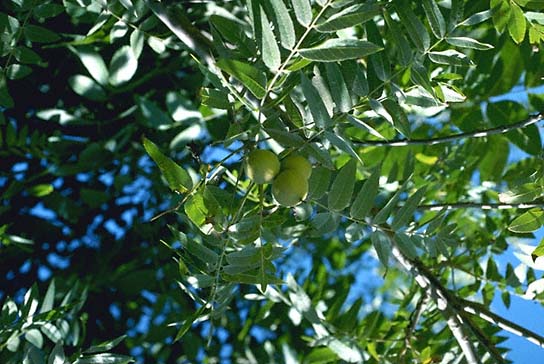|
|
|

California Walnut
(Juglans californica)
Description: Small to medium-sized tree, usually forked near base, with rounded crown.Height: 40' (12 m).
Diameter: 1' (0.3 m).
Leaves: pinnately compound; 6-9" (15-23 cm) long; axis with hairy glands. 11-15 leaflets 1-2 1/2" (2.5-6 cm) long; oblong lance-shaped, short- or long-pointed, finely saw-toothed; stalkless. Shiny green above, paler, with tufts of hairs along veins beneath; turning yellow or brown in autumn.
Bark: dark brown or blackish, rough and furrowed into broad ridges.
Twigs: brown, stout, with chambered pith.
Flowers: small, greenish; in early spring. Male with 30-40 stamens, numerous, in catkins 2-3" (5-7.5 cm) long. Female with 2-lobed style, few, at tip of same twig.
Fruit: 1-1 1/4" (2.5-3 cm) in diameter; walnut with thin, dark brown husk, thick, grooved shell, and edible seed; maturing in early autumn.
Habitat: Moist soils along streams in canyons and foothills; with cottonwoods, willows, and sycamores.
Range: Coastal s. California only; to 2500' (762 m).
Discussion: First found north of Los Angeles in 1850 by the survey of the Mexican Boundary Commission, this species is now established by planting beyond its local range. It is often small and shrublike; in contrast, Northern California Walnut becomes a tall tree with larger nuts to 2" (5 cm) in diameter.